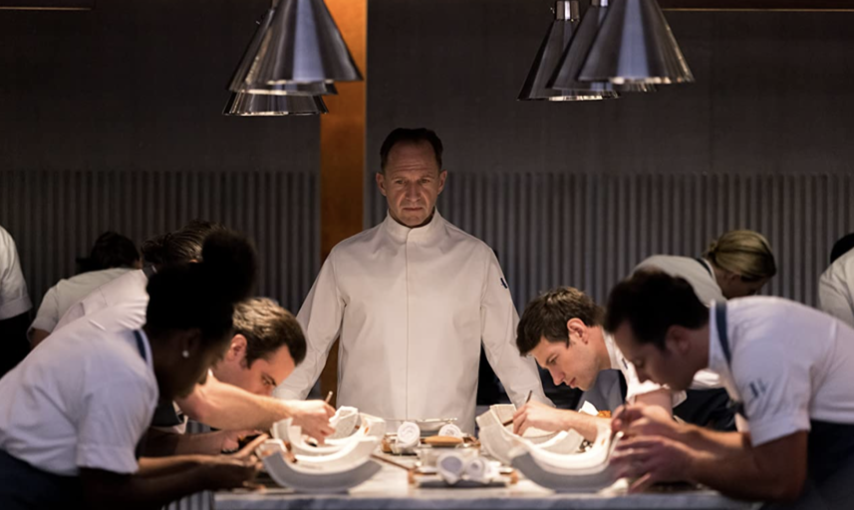“The Menu”: A Michelin Star Thriller

Image Courtesy of IMDB
By Kristijan Jakominich
All art is born of the bosom of the artist’s passion. Anyone who truly devotes themselves to the thing they love knows this sort of feeling. It’s a process that can’t be described with easy, specific language, as much as the lover can’t describe how they feel about their beloved. It’s a feeling that, once you have it, you never want it to leave.
However, in this modern day and age, where everything is seemingly commercialized, streamlined, and reduced to numbers on a screen, this robbery of the soul is evermore present. There is a feeling of being empty, a soul-crushing void that makes the artist bitter, dulled, and pained. It can even rouse one to anger and hatred. What happens when this feeling of bitter sorrow and anguish is allowed to boil over into real action? This is the concept of the movie, The Menu.
The Menu is a movie directed by Mark Mylod, and starring prominent actors like Ralph Fiennes, Anya Taylor-Joy, and Nicholas Hoult. While a cursory glance may indicate that this is a horror movie of sorts, it isn’t the same as any of the recent slashers and gorefests that have recently been on screen like Halloween Kills (2021) or M3GAN (2022). Nor, would I argue, is it quite in that same category of existential dread as recent, higher quality horror such as Hereditary (2018) or the star actress’ breakout movie, The Witch (2015). Rather, it falls into the category of a thriller.
The movie doesn’t contain many overt scares, and it doesn’t play many cheap tricks on the audience. Rather, the concept presents itself as it is, and the fantastic cinematography and the acting, especially that of Fiennes, carries it to another level than most movies you can find in theaters nowadays.
The movie’s premise is of an elite, private restaurant on a secluded island, manned by a Gordan Ramsay-esque chef with a crew of line chefs and staff that are zealously loyal to him. The guests, all of whom are wealthy clients or the companions thereof, are a standard cast of characters with colorful backgrounds, all of which come into play later on. The dishes served, the reviews given by the guests, especially those of a stereotypically snobbish food critic, all should be quite familiar to anyone who’s watched too many hours of The Food Network. The movie is laced with a subtle irony which adds a very refreshing twist to the more general thrilling aspects of the movie. It takes aim at every aspect of the fine dining industry at large, from the obsessive devotion both chefs and culinary laymen give to certain celebrity chefs, to the overbearing influence that out-of-touch critics and investors have to the dining experience.
I must confess that, despite the film’s climax putting the character of Julian Slowik, played masterfully by Fiennes, in the clear moral wrong, it’s very hard to not sympathize with him. To put simply, without spoiling too much of the specific plot details, the entire arc of the movie is Slowik’s culinary rendition of lashing out at those who he felt robbed him of his passion for cooking. The slow build-up, which begins to exponentially increase in intensity and depth, is presented as the chef’s magnum opus, his greatest menu yet. It requires a certain appreciation from the audience, and the viewer should suspend the idea of generic horror tropes such as “how can they get out of it?”. While much of the movie focuses on the character portrayed by Ms. Taylor-Joy, the real show-stealer is Ralph Fiennes.
Overall, the movie is a solid 4/5. With Fiennes really being the center of the movie’s attention, the other characters can feel a bit weaker, albeit not due to lack of effort or talent by the actors and actresses. This is really the only reason it doesn’t rate any higher, but it is very close to being as best as it can be. While it may be leaving theaters, having been released in November of last year, it is available on HBO Max and everyone should give it a watch when they find the time.
What can really be taken away from it isn’t any sort of specific social commentary, or single directed message let loose like an arrow at a specific target. Rather, it can be interpreted as a representation of the modern, tortured artist. It is a lamentation at the loss of the innocence of art, being perverted by the culture around it. While it takes its specific jabs at the given forces of the culinary world, it can be easily applied to any sphere of art. It can be said that, in this movie, the tortured artist gives his torment back to those who laid it upon him in the first place.





